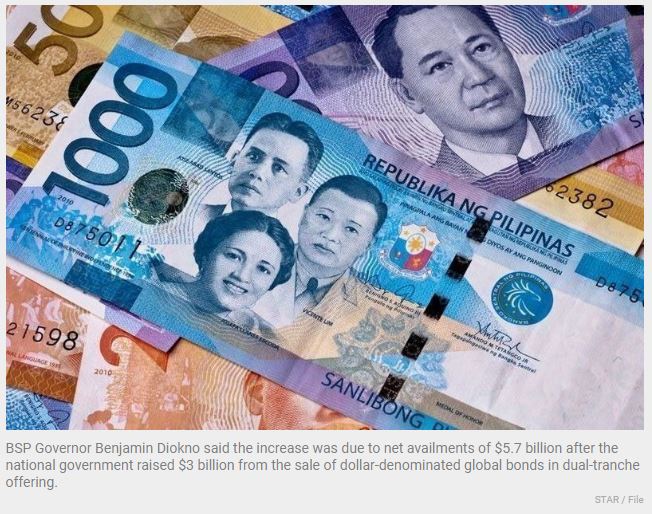Philippines: Debt rises to $106 billion on higher borrowings
MANILA, Philippines — The foreign obligations of the Philippines rose by 4.7 percent to $105.93 billion in end-September from $101.2 billion in end-June as the country received an emergency reserve fund from the International Monetary Fund (IMF), and also due to the higher borrowings by the government for its pandemic response measures.
BSP Governor Benjamin Diokno said the increase was due to net availments of $5.7 billion after the national government raised $3 billion from the sale of dollar-denominated global bonds in dual-tranche offering.
Diokno said the government also borrowed $1.3 billion from official sources to fund general financing requirements as well as COVID response programs.
The BSP chief pointed out that the $2.8 billion received from the IMF last Aug. 23 also raised the country’s reserve assets and external debt levels.
According to Diokno, prior periods’ adjustments of $573 million further contributed to the increase of the debt stock.
On the other hand, Diokno said resident investments in Philippine debt papers issued offshore worth $556 million partly mitigated the rise in the debt level.
From January to September, the country’s foreign obligations increased by 15.2 percent from $91.98 billion in the same period last year.
Diokno said the $13.95 billion year-on-year rise in external debt was due to net availments amounting to $14.3 billion mainly by the national government and private non-banks, as well as prior periods’ adjustments of $2.3 billion.
The increase was partly offset by the transfer of Philippine debt papers from a non-resident to residents worth $1.7 billion and a negative foreign exchange revaluation of $987 million.
The BSP chief said the country’s outstanding external debt remained at a prudent level as its ratio to gross domestic product (GDP) stood at 27.3 percent as of end-September.
He said the gross international reserves (GIR) level stood at $106.6 billion in end- September, equivalent to 8.8 times cover of the short-term debt.
Data showed the debt service ratio increased to 8.1 percent in the first nine months from last year’s 7.2 percent due to higher payments, while the total outstanding debt (EDT) expressed as a percentage of gross domestic product (GDP) remains one of the lowest compared to other countries in Southeast Asia.
Public sector external debt went up by 8.8 percent to $65.2 billion in end -September from $59.9 billion in end- June, accounting for 61.5 percent of the country’s foreign debt.
The national government accounted for 87.3 percent or $56.9 billion of the total public sector debt, while government-owned and controlled corporations, government financial institutions and the central bank cornered the remaining 12.7 percent or $8.4 billion.
Meanwhile, the foreign obligations of private companies amounted to $40.7 billion in end- September for a share of 38.5 percent.
According to the BSP, major creditor countries include Japan with $14.8 billion followed by the US with $2.9 billion, Netherlands with $2.8 billion, the United Kingdom with $2.4 billion, and China with $2.2 billion.
Loans in the form of bonds or notes had the largest share with 37.7 percent, followed by borrowings from multilateral lending institutions and bilateral creditors ( 37.3 percent) and obligations to foreign banks and other financial institutions (19.2 percent). The remaining 5.7 percent was owed to other creditors such as suppliers and exporters.
In terms of currency mix, the country’s debt stock remained largely denominated in dollar with 54.9 percent and Japanese yen with 10.1 percent. Dollar-denominated multi-currency loans from the World Bank and Asian Development Bank represented 19.4 percent.
Data showed the maturity profile of the country’s external debt remained predominantly medium and long-term in nature with original maturities longer than one year with share to total at 88.3 percent, while short-term accounts with maturities of up to one year comprised the 11.7 percent balance.
“This means that foreign exchange requirements for debt payments are well spread out and, thus, manageable,” Diokno said.
The national government borrows heavily from foreign and domestic creditors to finance the country’s budget deficit as it spends more than what it actually earns. The country’s budget shortfall ballooned as the pandemic-induced recession pulled down revenue collections, while spending soared to finance the pandemic response measures.
Source: https://www.philstar.com/business/2021/12/13/2147532/debt-rises-106-billion-higher-borrowings


 English
English




